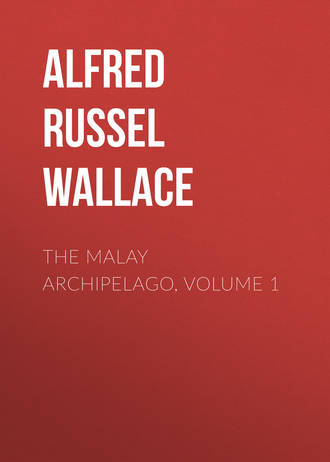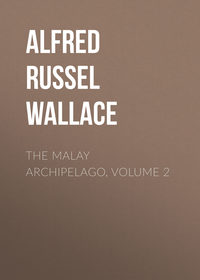 полная версия
полная версияThe Malay Archipelago, Volume 1
When I arrived at the mines, on the 14th of March, I had collected in the four preceding months, 320 different kinds of beetles. In less than a fortnight I had doubled this number, an average of about 24 new species every day. On one day I collected 76 different kinds, of which 34 were new to me. By the end of April I had more than a thousand species, and they then went on increasing at a slower rate, so that I obtained altogether in Borneo about two thousand distinct kinds, of which all but about a hundred were collected at this place, and on scarcely more than a square mile of ground. The most numerous and most interesting groups of beetles were the Longicorns and Rhynchophora, both pre-eminently wood-feeders. The former, characterised by their graceful forms and long antenna, were especially numerous, amounting to nearly three hundred species, nine-tenths of which were entirely new, and many of them remarkable for their large size, strange forms, and beautiful colouring. The latter correspond to our weevils and allied groups, and in the tropics are exceedingly numerous and varied, often swarming upon dead timber, so that I sometimes obtained fifty or sixty different kinds in a day. My Bornean collections of this group exceeded five hundred species.
My collection of butterflies was not large; but I obtained some rare and very handsome insects, the most remarkable being the Ornithoptera Brookeana, one of the most elegant species known. This beautiful creature has very long and pointed wings, almost resembling a sphinx moth in shape. It is deep velvety black, with a curved band of spots of a brilliant metallic-green colour extending across the wings from tip to tip, each spot being shaped exactly like a small triangular feather, and having very much the effect of a row of the wing coverts of the Mexican trogon, laid upon black velvet. The only other marks are a broad neck-collar of vivid crimson, and a few delicate white touches on the outer margins of the hind wings. This species, which was then quite new and which I named after Sir James Brooke, was very rare. It was seen occasionally flying swiftly in the clearings, and now and then settling for an instant at puddles and muddy places, so that I only succeeded in capturing two or three specimens. In some other parts of the country I was assured it was abundant, and a good many specimens have been sent to England; but as yet all have been males, and we are quite unable to conjecture what the female may be like, owing to the extreme isolation of the species, and its want of close affinity to any other known insect.
One of the most curious and interesting reptiles which I met with in Borneo was a large tree-frog, which was brought me by one of the Chinese workmen. He assured me that he had seen it come down in a slanting direction from a high tree, as if it flew. On examining it, I found the toes very long and fully webbed to their very extremity, so that when expanded they offered a surface much larger than the body. The forelegs were also bordered by a membrane, and the body was capable of considerable inflation. The back and limbs were of a very deep shining green colour, the undersurface and the inner toes yellow, while the webs were black, rayed with yellow. The body was about four inches long, while the webs of each hind foot, when fully expanded, covered a surface of four square inches, and the webs of all the feet together about twelve square inches. As the extremities of the toes have dilated discs for adhesion, showing the creature to be a true tree frog, it is difficult to imagine that this immense membrane of the toes can be for the purpose of swimming only, and the account of the Chinaman, that it flew down from the tree, becomes more credible. This is, I believe, the first instance known of a "flying frog," and it is very interesting to Darwinians as showing that the variability of the toes which have been already modified for purposes of swimming and adhesive climbing, have been taken advantage of to enable an allied species to pass through the air like the flying lizard. It would appear to be a new species of the genus Rhacophorus, which consists of several frogs of a much smaller size than this, and having the webs of the toes less developed.
During my stay in Borneo I had no hunter to shoot for me regularly, and, being myself fully occupied with insects, I did not succeed in obtaining a very good collection of the birds or Mammalia, many of which, however, are well known, being identical with species found in Malacca. Among the Mammalia were five squirrels,and two tigercats—the Gymnurus Rafflesii, which looks like a cross between a pig and a polecat, and the Cynogale Bennetti—a rare, otter-like animal, with very broad muzzle clothed with long bristles.
One of my chief objects in coming to stay at Simunjon was to see the Orangutan (or great man-like ape of Borneo) in his native haunts, to study his habits, and obtain good specimens of the different varieties and species of both sexes, and of the adult and young animals. In all these objects I succeeded beyond my expectations, and will now give some account of my experience in hunting the Orangutan, or "Mias," as it is called by the natives; and as this name is short, and easily pronounced, I shall generally use it in preference to Simia satyrus, or Orangutan.
Just a week after my arrival at the mines, I first saw a Mias. I was out collecting insects, not more than a quarter of a mile from the house, when I heard a rustling in a tree near, and, looking up, saw a large red-haired animal moving slowly along, hanging from the branches by its arms. It passed on from tree to tree until it was lost in the jungle, which was so swampy that I could not follow it. This mode of progression was, however, very unusual, and is more characteristic of the Hylobates than of the Orang. I suppose there was some individual peculiarity in this animal, or the nature of the trees just in this place rendered it the most easy mode of progression.
About a fortnight afterwards I heard that one was feeding in a tree in the swamp just below the house, and, taking my gun, was fortunate enough to find it in the same place. As soon as I approached, it tried to conceal itself among the foliage; but, I got a shot at it, and the second barrel caused it to fall down almost dead, the two balls having entered the body. This was a male, about half-grown, being scarcely three feet high. On April 26th, I was out shooting with two Dyaks, when we found another about the same size. It fell at the first shot, but did not seem much hurt, and immediately climbed up the nearest tree, when I fired, and it again fell, with a broken arm and a wound in the body. The two Dyaks now ran up to it, and each seized hold of a hand, telling me to cut a pole, and they would secure it. But although one arm was broken and it was only a half-grown animal, it was too strong for these young savages, drawing them up towards its mouth notwithstanding all their efforts, so that they were again obliged to leave go, or they would have been seriously bitten. It now began climbing up the tree again; and, to avoid trouble, I shot it through the heart.
On May 2nd, I again found one on a very high tree, when I had only a small 80-bore gun with me. However, I fired at it, and on seeing me it began howling in a strange voice like a cough, and seemed in a great rage, breaking off branches with its hands and throwing them down, and then soon made off over the tree-tops. I did not care to follow it, as it was swampy, and in parts dangerous, and I might easily have lost myself in the eagerness of pursuit.
On the 12th of May I found another, which behaved in a very similar manner, howling and hooting with rage, and throwing down branches. I shot at it five times, and it remained dead on the top of the tree, supported in a fork in such a manner that it would evidently not fall. I therefore returned home, and luckily found some Dyaks, who came back with me, and climbed up the tree for the animal. This was the first full-grown specimen I had obtained; but it was a female, and not nearly so large or remarkable as the full-grown males. It was, however, 3 ft. 6 in. high, and its arms stretched out to a width of 6 ft. 6 in. I preserved the skin of this specimen in a cask of arrack, and prepared a perfect skeleton, which was afterwards purchased for the Derby Museum.
Only four days afterwards some Dyaks saw another Mias near the same place, and came to tell me. We found it to be a rather large one, very high up on a tall tree. At the second shot it fell rolling over, but almost immediately got up again and began to climb. At a third shot it fell dead. This was also a full-grown female, and while preparing to carry it home, we found a young one face downwards in the bog. This little creature was only about a foot long, and had evidently been hanging to its mother when she first fell. Luckily it did not appear to have been wounded, and after we had cleaned the mud out of its mouth it began to cry out, and seemed quite strong and active. While carrying it home it got its hands in my beard, and grasped so tightly that I had great difficulty in getting free, for the fingers are habitually bent inwards at the last joint so as to form complete hooks. At this time it had not a single tooth, but a few days afterwards it cut its two lower front teeth. Unfortunately, I had no milk to give it, as neither Malays, Chinese nor Dyaks ever use the article, and I in vain inquired for any female animal that could suckle my little infant. I was therefore obliged to give it rice-water from a bottle with a quill in the cork, which after a few trials it learned to suck very well. This was very meagre diet, and the little creature did not thrive well on it, although I added sugar and cocoa-nut milk occasionally, to make it more nourishing. When I put my finger in its mouth it sucked with great vigour, drawing in its cheeks with all its might in the vain effort to extract some milk, and only after persevering a long time would it give up in disgust, and set up a scream very like that of a baby in similar circumstances.
When handled or nursed, it was very quiet and contented, but when laid down by itself would invariably cry; and for the first few nights was very restless and noisy. I fitted up a little box for a cradle, with a soft mat for it to lie upon, which was changed and washed every day; and I soon found it necessary to wash the little Mias as well. After I had done so a few times, it came to like the operation, and as soon as it was dirty would begin crying and not leave off until I took it out and carried it to the spout, when it immediately became quiet, although it would wince a little at the first rush of the cold water and make ridiculously wry faces while the stream was running over its head. It enjoyed the wiping and rubbing dry amazingly, and when I brushed its hair seemed to be perfectly happy, lying quite still with its arms and legs stretched out while I thoroughly brushed the long hair of its back and arms. For the first few days it clung desperately with all four hands to whatever it could lay hold of, and I had to be careful to keep my beard out of its way, as its fingers clutched hold of hair more tenaciously than anything else, and it was impossible to free myself without assistance. When restless, it would struggle about with its hands up in the air trying to find something to take hold of, and, when it had got a bit of stick or rag in two or three of its hands, seemed quite happy. For want of something else, it would often seize its own feet, and after a time it would constantly cross its arms and grasp with each hand the long hair that grew just below the opposite shoulder. The great tenacity of its grasp soon diminished, and I was obliged to invent some means to give it exercise and strengthen its limbs. For this purpose I made a short ladder of three or four rounds, on which I put it to hang for a quarter of an hour at a time. At first it seemed much pleased, but it could not get all four hands in a comfortable position, and, after changing about several times, would leave hold of one hand after the other, and drop onto the floor. Sometimes when hanging only by two hands, it would loose one, and cross it to the opposite shoulder, grasping its own hair; and, as this seemed much more agreeable than the stick, it would then loose the other and tumble down, when it would cross both and lie on its back quite contentedly, never seeming to be hurt by its numerous tumbles. Finding it so fond of hair, I endeavoured to make an artificial mother, by wrapping up a piece of buffalo-skin into a bundle, and suspending it about a foot from the floor. At first this seemed to suit it admirably, as it could sprawl its legs about and always find some hair, which it grasped with the greatest tenacity. I was now in hopes that I had made the little orphan quite happy; and so it seemed for some time, until it began to remember its lost parent, and try to suck. It would pull itself up close to the skin, and try about everywhere for a likely place; but, as it only succeeded in getting mouthfuls of hair and wool, it would be greatly disgusted, and scream violently, and, after two or three attempts, let go altogether. One day it got some wool into its throat, and I thought it would have choked, but after much gasping it recovered, and I was obliged to take the imitation mother to pieces again, and give up this last attempt to exercise the little creature.
After the first week I found I could feed it better with a spoon, and give it a little more varied and more solid food. Well-soaked biscuit mixed with a little egg and sugar, and sometimes sweet potatoes, were readily eaten; and it was a never-failing amusement to observe the curious changes of countenance by which it would express its approval or dislike of what was given to it. The poor little thing would lick its lips, draw in its cheeks, and turn up its eyes with an expression of the most supreme satisfaction when it had a mouthful particularly to its taste. On the other hand, when its food was not sufficiently sweet or palatable, it would turn the mouthful about with its tongue for a moment as if trying to extract what flavour there was, and then push it all out between its lips. If the same food was continued, it would set up a scream and kick about violently, exactly like a baby in a passion.
After I had had the little Mias about three weeks, I fortunately obtained a young hare-lip monkey (Macacus cynomolgus), which, though small, was very active, and could feed itself. I placed it in the same box with the Mias, and they immediately became excellent friends, neither exhibiting the least fear of the other. The little monkey would sit upon the other's stomach, or even on its face, without the least regard to its feelings. While I was feeding the Mias, the monkey would sit by, picking up all that was spilt, and occasionally putting out its hands to intercept the spoon; and as soon as I had finished would pick off what was left sticking to the Mias' lips, and then pull open its mouth and see if any still remained inside; afterwards lying down on the poor creature's stomach as on a comfortable cushion. The little helpless Mias would submit to all these insults with the most exemplary patience, only too glad to have something warm near it, which it could clasp affectionately in its arms. It sometimes, however, had its revenge; for when the monkey wanted to go away, the Mias would hold on as long as it could by the loose skin of its back or head, or by its tail, and it was only after many vigorous jumps that the monkey could make his escape.
It was curious to observe the different actions of these two animals, which could not have differed much in age. The Mias, like a very young baby, lying on its back quite helpless, rolling lazily from side to side, stretching out all four hands into the air, wishing to grasp something, but hardly able to guide its fingers to any definite object; and when dissatisfied, opening wide its almost toothless mouth, and expressing its wants by a most infantine scream. The little monkey, on the other hand, in constant motion, running and jumping about wherever it pleased, examining everything around it, seizing hold of the smallest object with the greatest precision, balancing itself on the edge of the box or running up a post, and helping itself to anything eatable that came in its way. There could hardly be a greater contrast, and the baby Mias looked more baby-like by the comparison.
When I had had it about a month, it began to exhibit some signs of learning to run alone. When laid upon the floor it would push itself along by its legs, or roll itself over, and thus make an unwieldy progression. When lying in the box it would lift itself up to the edge into almost an erect position, and once or twice succeeded in tumbling out. When left dirty, or hungry, or otherwise neglected, it would scream violently until attended to, varied by a kind of coughing or pumping noise very similar to that which is made by the adult animal. If no one was in the house, or its cries were not attended to, it would be quiet after a little while, but the moment it heard a footstep would begin again harder than ever.
After five weeks it cut its two upper front teeth, but in all this time it had not grown the least bit, remaining both in size and weight the same as when I first procured it. This was no doubt owing to the want of milk or other equally nourishing food. Rice-water, rice, and biscuits were but a poor substitute, and the expressed milk of the cocoa-nut which I sometimes gave it did not quite agree with its stomach. To this I imputed an attack of diarrhoea from which the poor little creature suffered greatly, but a small dose of castor-oil operated well, and cured it. A week or two afterwards it was again taken ill, and this time more seriously. The symptoms were exactly those of intermittent fever, accompanied by watery swellings on the feet and head. It lost all appetite for its food, and, after lingering for a week a most pitiable object, died, after being in my possession nearly three months. I much regretted the loss of my little pet, which I had at one time looked forward to bringing up to years of maturity, and taking home to England. For several months it had afforded me daily amusement by its curious ways and the inimitably ludicrous expression of its little countenance. Its weight was three pounds nine ounces, its height fourteen inches, and the spread of its arms twenty-three inches. I preserved its skin and skeleton, and in doing so found that when it fell from the tree it must have broken an arm and a leg, which had, however, united so rapidly that I had only noticed the hard swellings on the limbs where the irregular junction of the bones had taken place.
Exactly a week after I had caught this interesting little animal, I succeeded in shooting a full-grown male Orangutan. I had just come home from an entomologising excursion when Charles [Charles Allen, an English lad of sixteen, accompanied me as an assistant] rushed in out of breath with running and excitement, and exclaimed, interrupted by gasps, "Get the gun, sir,—be quick,—such a large Mias!" "Where is it?" I asked, taking hold of my gun as I spoke, which happened luckily to have one barrel loaded with ball. "Close by, sir—on the path to the mines—he can't get away." Two Dyaks chanced to be in the house at the time, so I called them to accompany me, and started off, telling Charley to bring all the ammunition after me as soon as possible. The path from our clearing to the mines led along the side of the hill a little way up its slope, and parallel with it at the foot a wide opening had been made for a road, in which several Chinamen were working, so that the animal could not escape into the swampy forest below without descending to cross the road or ascending to get round the clearings. We walked cautiously along, not making the least noise, and listening attentively for any sound which might betray the presence of the Mias, stopping at intervals to gaze upwards. Charley soon joined us at the place where he had seen the creature, and having taken the ammunition and put a bullet in the other barrel, we dispersed a little, feeling sure that it must be somewhere near, as it had probably descended the hill, and would not be likely to return again.
After a short time I heard a very slight rustling sound overhead, but on gazing up could see nothing. I moved about in every direction to get a full view into every part of the tree under which I had been standing, when I again heard the same noise but louder, and saw the leaves shaking as if caused by the motion of some heavy animal which moved off to an adjoining tree. I immediately shouted for all of them to come up and try and get a view, so as to allow me to have a shot. This was not an easy matter, as the Mias had a knack of selecting places with dense foliage beneath. Very soon, however, one of the Dyaks called me and pointed upwards, and on looking I saw a great red hairy body and a huge black face gazing down from a great height, as if wanting to know what was making such a disturbance below. I instantly fired, and he made off at once, so that I could not then tell whether I had hit him.
He now moved very rapidly and very noiselessly for so large an animal, so I told the Dyaks to follow and keep him in sight while I loaded. The jungle was here full of large angular fragments of rock from the mountain above, and thick with hanging and twisted creepers. Running, climbing, and creeping among these, we came up with the creature on the top of a high tree near the road, where the Chinamen had discovered him, and were shouting their astonishment with open mouths: "Ya Ya, Tuan; Orangutan, Tuan." Seeing that he could not pass here without descending, he turned up again towards the hill, and I got two shots, and following quickly, had two more by the time he had again reached the path, but he was always more or less concealed by foliage, and protected by the large branch on which he was walking. Once while loading I had a splendid view of him, moving along a large limb of a tree in a semi-erect posture, and showing it to be an animal of the largest size. At the path he got on to one of the loftiest trees in the forest, and we could see one leg hanging down useless, having been broken by a ball. He now fixed himself in a fork, where he was hidden by thick foliage, and seemed disinclined to move. I was afraid he would remain and die in this position, and as it was nearly evening. I could not have got the tree cut down that day. I therefore fired again, and he then moved off, and going up the hill was obliged to get on to some lower trees, on the branches of one of which he fixed himself in such a position that he could not fall, and lay all in a heap as if dead, or dying.
I now wanted the Dyaks to go up and cut off the branch he was resting on, but they were afraid, saying he was not dead, and would come and attack them. We then shook the adjoining tree, pulled the hanging creepers, and did all we could to disturb him, but without effect, so I thought it best to send for two Chinamen with axes to cut down the tree. While the messenger was gone, however, one of the Dyaks took courage and climbed towards him, but the Mias did not wait for him to get near, moving off to another tree, where he got on to a dense mass of branches and creepers which almost completely hid him from our view. The tree was luckily a small one, so when the axes came we soon had it cut through; but it was so held up by jungle ropes and climbers to adjoining trees that it only fell into a sloping position. The Mias did not move, and I began to fear that after all we should not get him, as it was near evening, and half a dozen more trees would have to be cut down before the one he was on would fall. As a last resource we all began pulling at the creepers, which shook the tree very much, and, after a few minutes, when we had almost given up all hope, down he came with a crash and a thud like the fall of a giant. And he was a giant, his head and body being fully as large as a man's. He was of the kind called by the Dyaks "Mias Chappan," or "Mias Pappan," which has the skin of the face broadened out to a ridge or fold at each side. His outstretched arms measured seven feet three inches across, and his height, measuring fairly from the top of the head to the heel was four feet two inches. The body just below the arms was three feet two inches round, and was quite as long as a man's, the legs being exceedingly short in proportion. On examination we found he had been dreadfully wounded. Both legs were broken, one hip-joint and the root of the spine completely shattered, and two bullets were found flattened in his neck and jaws. Yet he was still alive when he fell. The two Chinamen carried him home tied to a pole, and I was occupied with Charley the whole of the next day preparing the skin and boiling the bones to make a perfect skeleton, which are now preserved in the Museum at Derby.









